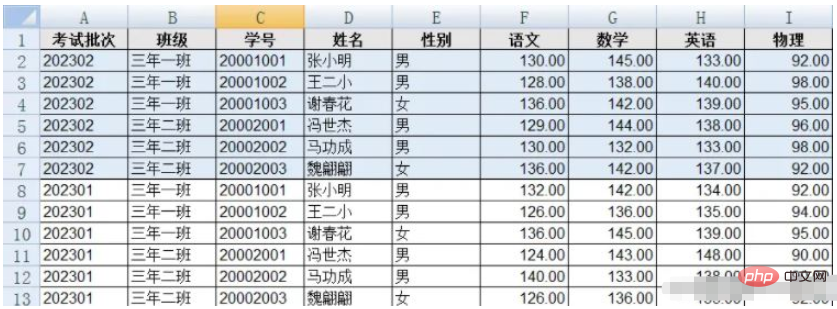ホームページ >Java >&#&チュートリアル >Javaで傾向比較データを自動生成する方法は何ですか?
Javaで傾向比較データを自動生成する方法は何ですか?
- 王林転載
- 2023-05-03 09:37:06984ブラウズ
背景
データ間のペアごとのトレンド比較は、以下に示すように、データ分析アプリケーションにおける非常に一般的なアプリケーション シナリオです。
| 模擬テスト バッチ | クラス | 学生 | 中国語 | 数学 | 英語 |
|---|---|---|---|---|---|
| クラス3年 | 张小明 | 130 | 145 | 133 | |
| 三级一 | 王二小 | 128 | 138 | 140 | |
| 3年3組 | 謝春華 | 136 | 142 | 139 | |
| 3年クラス | 張暁明 | 132 | 140 | 128 | |
| 3年3組 | 王二小 | 125 | 146 | 142 | |
| 3年3組 | 謝春華 | 138 | 143 | 140 | |
| 3年クラス | 張暁明 | 135 | 138 | 120 | |
| 三级一級 | 王二小 | 123 | 145 | 138 | |
| 3年3組 | 謝春華 | 136 | 140 | 142 |
| 学生 | 中国語 | 数学 | English | ##202302 と 202301 の比較 | |
|---|---|---|---|---|---|
| 張暁明 | -2 | 5 | 5 | 202302 と 202301 の比較 | |
| 王二小 | 3 | -8 | #-2 | 202302 と 202301 の比較 | |
| 謝春華 | -2 | -1 | -1 | #202301 と 202212 の比較 | Three -年クラス |
| -3 | 2 | 8 | 202301 と 202212 の比較 | 三一级 | |
| 2 | 1 | 4 | 202301 と 202212 の比較 | クラス 3 年 | |
| 2 | 3 | -2 | 詳細な設計と実装 |
- 前置フィールド
- 比較フィールド リスト
- 例:
異なる
試験バッチの各クラスの各生徒の進歩と衰退
上記の要件を定義されたクラスにマッピングした結果は次のようになります。 件名フィールド リスト (
クラス、学生)
前置詞フィールド (試験バッチ)
比較項目一覧(各科目:中国語、数学、英語)
-
トレンド比率 実行用class、このクラスは次のような外部呼び出しのメソッドを提供します
public static <T> List<T> compare(List<T> dataList, TrendCompare trendCompare) { Map<String, List<T>> groupMap = group(dataList, null, trendCompare.subjectFields()); List<T> resultList = new ArrayList<>(); for (List<T> groupDataList : groupMap.values()) { List<T> diffValueList = new ArrayList<>(); int size = groupDataList.size(); if (size > 1) { for (int i = 0; i < size - 1; i++) { //数据之间两两比较 diffValue = minuend - subtrahend T minuend = groupDataList.get(i); T subtrahend = groupDataList.get(i + 1); T diffValue = minus(trendCompare.compareFields(), minuend, subtrahend); //设置主体信息 if (trendCompare.subjectFields() != null) { for (String subjectField : trendCompare.subjectFields()) { setFieldValue(diffValue, subjectField, getFieldValue(minuend, subjectField)); } } //设置介词字段信息 String atField = trendCompare.atField(); if (StringUtils.isNotEmpty(atField)) { setFieldValue(diffValue, atField, getFieldValue(minuend, atField) + "与" + getFieldValue(subtrahend, atField) + "对比增减"); } diffValueList.add(diffValue); } } if (diffValueList.size() > 0) { T firstData = groupDataList.get(0); Map<String, Object> valMap = new HashMap<>(); //指定的赋值集合进行赋值 if (trendCompare.assignValMap() != null) { for (Map.Entry<String, String> stringStringEntry : trendCompare.assignValMap().entrySet()) { String field = stringStringEntry.getKey(); if (!StringUtils.equalsAny(field, trendCompare.compareFields())) { String valueEL = stringStringEntry.getValue(); valMap.put(field, executeSpEL(valueEL, firstData)); } } } for (Map.Entry<String, Object> entry : valMap.entrySet()) { for (T diffValue : diffValueList) { setFieldValue(diffValue, entry.getKey(), entry.getValue()); } } } resultList.addAll(diffValueList); } return resultList; }ご覧のとおり、このメソッドには受信
- 2 つのパラメーターを定義し、最後にトレンド比較後の結果セットを返します。
- このメソッドの内部ロジックは、次の 2 つのステップに分割できます。
- ユース ケース
- 次のようなデータ セットがあるとします。
学生クラスを定義します。
public class Student {
private String batch;
private String banji;
private String studentNo;
private String name;
private String sex;
private Double yuwen;
private Double math;
private Double english;
private Double physics;
//extra
private String maxScoreName1;
public Student(String batch, String banji, String studentNo, String name, String sex, Double yuwen, Double math, Double english, Double physics) {
this.batch = batch;
this.banji = banji;
this.studentNo = studentNo;
this.name = name;
this.sex = sex;
this.yuwen = yuwen;
this.math = math;
this.english = english;
this.physics = physics;
}
}上記のデータを返すメソッドを作成します:
public List<Student> getDataList() {
List<Student> dataList = new ArrayList<>();
dataList.add(new Student("202302", "三年一班", "20001001", "张小明", "男", 130.0, 145.0, 133.0, 92.0));
dataList.add(new Student("202302", "三年一班", "20001002", "王二小", "男", 128.0, 138.0, 140.0, 98.0));
dataList.add(new Student("202302", "三年一班", "20001003", "谢春花", "女", 136.0, 142.0, 139.0, 95.0));
dataList.add(new Student("202302", "三年二班", "20002001", "冯世杰", "男", 129.0, 144.0, 138.0, 96.0));
dataList.add(new Student("202302", "三年二班", "20002002", "马功成", "男", 130.0, 132.0, 133.0, 98.0));
dataList.add(new Student("202302", "三年二班", "20002003", "魏翩翩", "女", 136.0, 142.0, 137.0, 92.0));
dataList.add(new Student("202301", "三年一班", "20001001", "张小明", "男", 132.0, 142.0, 134.0, 92.0));
dataList.add(new Student("202301", "三年一班", "20001002", "王二小", "男", 126.0, 136.0, 135.0, 94.0));
dataList.add(new Student("202301", "三年一班", "20001003", "谢春花", "女", 136.0, 145.0, 139.0, 95.0));
dataList.add(new Student("202301", "三年二班", "20002001", "冯世杰", "男", 124.0, 143.0, 148.0, 90.0));
dataList.add(new Student("202301", "三年二班", "20002002", "马功成", "男", 140.0, 133.0, 138.0, 90.0));
dataList.add(new Student("202301", "三年二班", "20002003", "魏翩翩", "女", 126.0, 136.0, 135.0, 92.0));
return dataList;
}トレンド比較定義と実行比較: 
List<Student> dataList = getDataList();
TrendCompare trendCompare = new TrendCompare()
.subjectFields("banji", "name")
.atField("batch")
.compareFields("yuwen", "math", "english")
//.assignVal("batch", "'环比增减'")
;
List<Student> resultList = DataProcessUtil.compare(dataList, trendCompare);
for (Student result : resultList) {
System.out.println(JSON.toJSONString(result));
}結果は次のとおりです: {"banji":"三年一班","batch":"202302与202301对比增减","english":-1.0,"math":3.0,"name":"张小明","yuwen":-2.0}
{"banji":"三年一班","batch":"202302与202301对比增减","english":5.0,"math":2.0,"name":"王二小","yuwen":2.0}
{"banji":"三年一班","batch":"202302与202301对比增减","english":0.0,"math":-3.0,"name":"谢春花","yuwen":0.0}
{"banji":"三年二班","batch":"202302与202301对比增减","english":-10.0,"math":1.0,"name":"冯世杰","yuwen":5.0}
{"banji":"三年二班","batch":"202302与202301对比增减","english":-5.0,"math":-1.0,"name":"马功成","yuwen":-10.0}
{"banji":"三年二班","batch":"202302与202301对比增减","english":2.0,"math":6.0,"name":"魏翩翩","yuwen":10.0}以上がJavaで傾向比較データを自動生成する方法は何ですか?の詳細内容です。詳細については、PHP 中国語 Web サイトの他の関連記事を参照してください。
声明:
この記事はyisu.comで複製されています。侵害がある場合は、admin@php.cn までご連絡ください。

